
Time Traveler’s Guide to Celiac Disease
Day: September 20th, 2008 Time: 9:00am Place: Ripon Medical Center
Our very first topic was The History of Celiac Disease. Knowing the backstory on this condition gives us a better understanding. Over the years, I’d add bits and pieces to this article, but it has remained on the back burner for a couple of years…until now. I felt Celiac Awareness Month was a perfect time to finally let this work-in-progress see the light of day. I hope you enjoy reading this as much as I did researching it.
Al Klapperich Branch Manager Gluten Intolerance Group of East Central WI
-
PrefaceTime Traveler’s Guide to Celiac Disease - By Alan Klapperich

Many people have never heard of celiac disease, until a friend, family member, loved one, or even themselves were diagnosed with this condition. Despite it being one of the most common auto-immune conditions in the world, 83% of those who have it are undiagnosed.
While it may be new to many, it's been plaguing mankind for thousands of years.
Fasten your seat belts, because we are going to be hopping around time to give you a bit of history on this new-ancient disease.
We're off to a time when men were men and women probably didn't look like Rachel Welch. Surprisingly, the 21st-century male isn’t much different than the Paleolithic male. Go figure… Why mess with perfection, right?
Paleolithic Era here we come! -
Paleolithic ManIt's dusk and just ahead is a flickering camp fire. The men have returned from a hunt. By their boastful behavior, we can assume it was successful. They will have fresh meat for their meal tonight. The women and children are preparing what they have gathered earlier in the day.
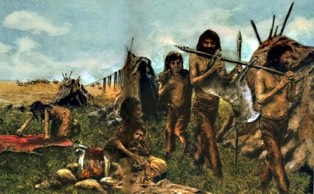
Their diet consists of small wild game, eggs, fish, nuts, berries, fruits, vegetables, leaves, roots, seeds. When ever possible, most hunter-gather societies try to consume over half of their calories from animal sources. This lifestyle sustained our ancestors for two and one-half million years – until the last 10,000 years – that's when the trouble started.
Eventually our ancestors figured out how to grow plants, kicking off the Neolithic Era and the agricultural revolution. The hunter-gatherer way of life was replaced by domesticated crops and animals. While this lifestyle change was much more convenient, it came with some unwanted results. Humans had over 2 million years for their gut to evolve into a very sophisticated organ. It was able to handle food antigens that had become staples of the human diet. Since a large percentage of our immune system is housed in the gut, there will be consequences when things get altered.
Farmers of the Neolithic period experienced a slew of new food antigens they never had before - proteins from cow, goat, donkey milk and cereal grains just to name a few.
Hello food intolerances and celiac disease.We must be moving on. The H.G. Wells time machine was a bit too cramped.
Dr. Who’s T.A.R.D.I.S. is the perfect vehicle. Yes, it’s the size of a phone booth, but don’t worry, it’s bigger on the inside. It’s always slightly larger than it needs to be. Com’on in…don’t worry…plenty of room. Remind me to tell you about the swimming pool…Additional information
”Quantifying the Hunter-Gatherer Food Choices” by Loren Cordain, PH.D
”Frontiers in Celiac Disease” Historical Perspective of Celiac Disease by Stefano Guandalini, MD
Our ancestors have been gluten-free for over 99% of their existence.
If we squash the past 2.5 million years in to a single calendar year, we have only been eating gluten for 1.5 days.
”What happened to the first wheat eaters?” by Dr. William Davis
-
Aretaeus of Cappadocia (circa 150 AD)During the second century, the Roman Empire was enjoying greater prosperity under the rulers known as The Five Good Emperors of Rome.

The inventions and innovations the Romans created changed the world forever. They left indelible marks on architecture, entertainment, government, lifestyle, science, and medicine. Their influences can still be felt in the 21st century.
We find an amazing Greek physician named Aretaeus of Cappadocia. Historians suspect he studied medicine in Alexandria, Egypt, but practiced in Rome based upon specific wines he prescribed known only to second century Rome. Many specific details of Aretaeus life are uncertain.
Aretaeus was said to have written seven or eight works. The lost works covered fevers, surgery, pharmacology and gynecology and prophylaxis (preventative treatment of disease). On the Causes and Symptoms of Acute and Chronic Diseases and Book on the Treatment of Acute and Chronic Diseases are two works known to have survived.
His writing revealed that he was an accurate observer as he described conditions like diabetes, pneumonia, pleurisy, tuberculosis, tetanus, diphtheria, paralysis, and something he called “Koiliakos” which meant "suffering in the bowels". Koiliakos is derived from the Greek word “koilia” which means abdomen. We know this condition as celiac disease.
In "The Coeliac Affection”, he describes the disease:
"If the stomach be irretentive of food and if it pass through undigested and crude, and nothing ascends into the body, we call such person koiliakos”.
“…heavy pain of the stomach now and then, as if from a puncture; the patient emaciated and atrophied, pale, feeble, incapable of performing any of his accustomed works. But if he attempt to walk, the limbs fail; the veins in the temples are prominent, for owing to wasting, the temples are hollow; but also over all the body the veins are enlarged, for not only does the disease not digest properly, but it does not even distribute that portion in which the digestion had commenced for the support of the body; it appears to me, therefore, to be an affection, not only of the digestion, but also of the distribution.”Additional information
Aretaeus of Cappadocia Biography - eNotes.com bit.ly/2pkVQTZ
Dictionary of World Biographay Volume 1 by Frank Northern Magill Aretaeus of Cappadocia - Starting on page 110.
A History of Celiac Disease.
García Nieto VM. In Rodrigo L and Peña AS, editors. Celiac Disease and Non-Celiac Gluten Sensitvity. Barcelona, Spain: OmniaScience; 2014. p. 45-59.
Language history lesson - Koiliakos: In translation from Greek to Latin, the ‘k’ became ‘c’ and ‘oi’ became ‘oe’. Dropping the Greek adjectival ending ‘os’ gave us the word coeliac – the British spelling.
Ancient bones show signs of struggle with coeliac disease by Ewen Callaway Nature.com - April 30, 2014 Two-thousand-year-old remains of an 18-20-year-old female were found in a Tuscan tomb
Researchers found evidence of malnutrition, osteoporosis, and two copies of the celiac genes in this 4’ 7” (short of stature) affluent woman.
These findings strongly suggest celiac disease.
Read more: Nature.com
-
Matthew Baillie (1761 - 1823)
We find ourselves in the early 1800s to meet a Scottish teacher, physician, pathologist and famed anatomist by the name of Matthew Baillie.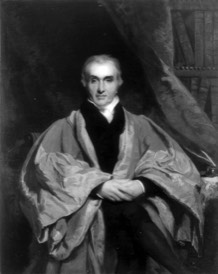
Baillie, a keen observer with an uncanny ability explain difficult subject matter in a simplistic and understandable manner. He was admired both professionally and personally.
In 1795, he published the American version of “Morbid Anatomy of the Human Body”; a first of its kind textbook that described pathology according to the organs involved instead of the symptoms.
In 1814, Baillie also published his observations on a chronic adult diarrheal disorder. In “Observations on a Particular Species of Purging” he describes patients with malnutrition and a gas-distended abdomen.
He noted that many adult patients had lived in warm, tropical climates. It is suspected that Baillie may have been describing the condition Tropical Sprue (a cousin to Celiac Sprue).
He describes his observations:
“They [stools] are pale in their colour, as if lime were mixed with water, are very frothy, like yeast at the top and often smell very sour. atients labouring under this complaint have generally more or less of a sallow countenance, and are thin, but more very much emaciated.
Patients afflicted with this kind of purging often live for several years, but the disease continues, subject to the changes lately described; and they hardly ever recover.”
He was also astute enough to notice and suggest dietetic treatment.
“Although this disease continues its progress, under every kind of diet, yet some patients appeared to derive considerable advantage from living almost entirely upon rice.”
Sadly, Baillie's observations went primarily unnoticed.We're not done with the 19th Century yet. Please allow my associates to set the WABAC Machine for London, 1887.
Additional information
Half-Yearly Abstract of the Medical Sciences January - June 1853 By William Harcourt Ranking, Charles Bland Radcliffe, William Dommett Stone bit.ly/1IipLDD The Works of Matthew Baillie, M.D. (1825)by James Wardrop bit.ly/2pQJaYo “There are many professions where negligence or inattention may be reckoned a folly; but in medicine it is a crime” ~ Matthew Baillie.
-
Samuel Gee (1839 - 1911)In 1887, crowds were jamming the streets to catch a royal wave from Queen Victoria as she processes from Buckingham Palace to Westminster Abbey. She's off to attend her Golden Jubilee celebration.
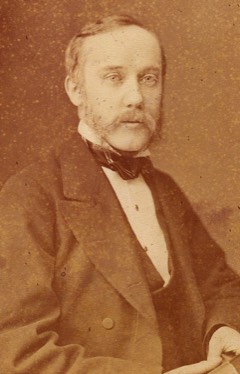
Despite the opulent celebration, the country is in the midst of a deep recession with skyrocketing unemployment rates.
Homeless families are camping in Trafalgar Square. They were hoping the fountains offer some refuge from the oppressive heat.
Charitable organizations provided free loaves of bread to those in need; however, the police felt the need to clear the square on a nightly basis. The Home Secretary decided to outlaw public meetings in the square. This act ignited violent displays of protest, condemning the disparity between rich and poor resulted in at least a hundred deaths. This skirmish became known as Bloody Sunday.
October 5th, only eight weeks before Bloody Sunday, Dr. Samuel Gee describes celiac disease during a lecture to medical students at the Hospital for Sick Children.
“...a kind of chronic indigestion which is met with in persons of all ages.”
He noted symptoms of wasting, weakness, and pallor would take precedence over the bowel issues. He also stated that food management was necessary, and errors in direction might cause the symptoms.
“...But if the patient can be cured at all, it must be by means of diet”, Gee stated.
In 1888 Gee writes in St. Bartholomew's Hospital Reports his description called “The Coeliac Affection.”
"There is a kind of chronic indigestion which is met with in persons of all ages, yet is especially apt to affect children between one and five years old. Signs of the disease are yielded by the fæces; being loose, not formed, but not watery; more bulky than the food taken would seem to account for; pale in colour, as if devoid of bile; yeasty, frothy, an appearance probably due to fermentation; stinking, stench often very great, the food having undergone putrefaction rather than concoction."
Does "Coeliac Affection" sound familiar? Gee likely paid homage to Aretaeus by using the same title. Other similarities to Aretaeus' writings were also noted throughout Gee's report. Gee's ability to read Greek may have attributed to the similarities.
It should be noted that Gee was the first to observe celiac disease in all ages, particularly in children. Aretaeus recorded this only in adults, more commonly found in the aged and women.
Noticing the food connection, Gee felt "the allowance of farinaceous (starchy) food must be small." He reports of a child doing amazingly well when fed a quart of the best Dutch mussels every day. However, once the mussel season was over – the child relapsed. Funny thing, the child couldn't be persuaded to eat the mussels the following season.
Gee documents the improvement and relapse connection to food. Keep in mind, Gee still really hasn't connected all the dots. He banned fruits and vegetables, but yet still allowed thin slices of [wheat] toast. Milk intolerance was also noticed in his patients. He's so close - lactose intolerance can be a direct result of damaged villi. Much like Scottish teacher, physician, pathologist, and famed anatomist Matthew Baillie, Gee's work went mostly unnoticed by his contemporaries.
Gee reportedly performed over 600 autopsies during his medical career. However, in his report on celiac disease he only included this single comment:
“Naked-eye examination of dead bodies throws no light up the nature of the coeliac affection: nothing unnatural can be seen in the stomach, intestines, or other digestive organs. Whether atrophy of the glandular crypts of the intestines be ever or always present, I cannot tell.”Hope you brought your swimming suit, because we’re taking a dip in the Hot Tub Time Machine. We’ll be swimming across the Big Pond. Take a deep breath…
Additional information
Diagnosis and treatment of coeliac disease - Samuel Gee http://1.usa.gov/1H0JwMX British Medical Journal - Samuel Gee, Aretaeus, and the Coeliac Affection bit.ly/2pQJaYo ”…But if the patient can be cured at all, it must be by means of diet.” ~ Samuel Gee
Celiac Awareness Day is September 13th; which is Samuel Gee’s Birthday
-
Christian Archibald Herter (1865-1910)We find ourselves in the United States of America, the year 1908. Technology is making a lot headlines.
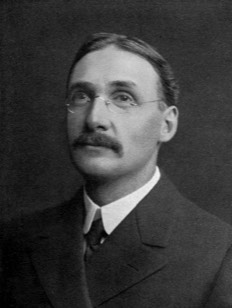
Ringing in 1908 begins with the very first ball dropping at Times Square. Happy New Year! We see the start of New York to Paris automobile race (via the frozen Bering Straits), the first of it’s kind [this was a time when the horse was more reliable than a car]. Race winning time is 88 days. Five years after the first airplane flight, the Wright Brothers include one of their mechanics on a flight. The first airplane passenger opens the door for a new way to travel.
Christian Herter publishes “Observations on Intestinal Infantilism”. He wanted to spread awareness of an intestinal disorder that wasn’t generating much interest in the medical community. For 12 years he had been observing a condition associated with arrested body development.
Herter was seeing this condition in children of various ages from 2 through 6 years. These children had been sick for one year or longer with noticeable differences in their digestive tracts. All of the children had histories of interrupted nutrition with weight loss as well as periods of improved nutrition and weight gain. The disease was seen in almost all cases of children in well-to-do families. They suspected children from poorer class families didn’t survive long if they had this condition.
Herter describes Intestinal Infantilism:
“The chief or essential clinical features are the following: (1) an arrest in the development of the body; (2) the maintenance of mental powers and fair development of the brain; (3) marked abdominal distention; (4) moderate grade of anaemia; (5) rapid onset of physical and mental fatigue; (6) various obtrusive irregularities referable to the intestinal tract.
Herter focused a lot on the bacterial makeup of the intestinal tract. He was interested in the effects of diet change and the change in bacterial flora.
In the 21st century, medicine continues to study the 100 trillion microorganisms (microbiata) that inhabit our intestinal tract. Science is starting to draw many connections between the health of our microbiota and the health of our bodies. Since a large percentage of our immune system is housed in the gut, it adds some credibility to Hippocrates’ quote “All disease begins in the gut.”
Like his predecessors, Herter also notes the importance of dietary intervention.
“Dietetic measures are the keystone of the therapeutic arch in infantilism. Without the closest attention to them there is little chance of beneficially modifying the intestinal processes which underlie the affection.”
He found it necessary to experiment so he could individualize and optimize a diet for each patient. He wanted adequate nutritional intake with “as little waste as possible from non-absorption and as little opportunity as possible for excessive putrefaction”. Dietary tweaks focused on carbohydrates, fats, proteins, gelatin; noting fats were better tolerated than carbohydrates. He determined that in the severest forms of this condition only very small amount of carbohydrates could be tolerated; potatoes were the most objectionable. However, he was still allowing Huntley & Palmers Breakfast Biscuit [I suspect they were not gluten-free].
His work in Intestinal Infantilism would get his name attached to this baffling condition. Gee-Herter Disease would later be changed to Celiac Disease.Additional information
Collected papers of Christian A. Herter, Volume 2 By Christian Archibald Herter http://bit.ly/1IYebbx On Infantilism from Chronic Intestinal Infection: Characterized by the over-growth and persistence of flora of the nursling period. by Christian Archibald Herter Want to know more about the invisible community that lives in and on you...and really defines who you are?
bit.ly/2pQJaYo ”Dietetic measures are the keystone of the therapeutic arch in infantilism. Without the closest attention to them there is little chance of beneficially modifying the intestinal processes which underlie the affection.” ~ Christian Archibald Herter
Christian Archibald Herter passed away at the age of 45 from a neurological wasting disease - possibly myasthenia gravis.
-
Sidney Valentine Haas (1870 - 1964)The Roaring Twenties are bringing about dramatic changes in the social and political fabric of society. For the first time in US history, more people are living in cities than on farms. Women are pushing the envelope with their sassy new looks to match their bolder behavior and attitude towards life. Their voices are being heard socially, and now politically with the passing of the 19th Amendment (Women’s Right to Vote).
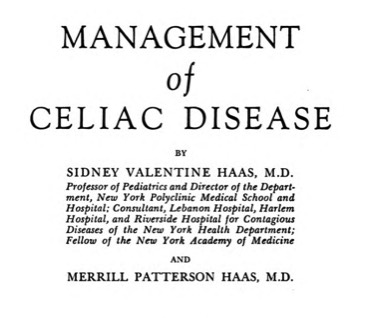
Radical changes also make their way into medicine. A new treatment bursts on to the scene that would become the therapy of choice for decades to come.
Behold the power of the banana!
In 1924 a New York City pediatrician Sidney Haas described his successful treatment of eight children whom he diagnosed with celiac disease. Because he had success in treating anorexia patients with bananas, he wanted to try it with these eight kids who were also anoretic (lack of appetite).
He published 10 cases - 8 of them treated - which he stated they were "clinically cured" with the banana diet while the 2 untreated had died. His paper was an enormous success and the banana diet was popular for decades. This discovery had a huge impact on celiac children and undoubtedly saved many lives. One key element in the banana diet really wasn’t the humble banana, but rather it contained no bread [gluten], no crackers [gluten], no potatoes, and no cereals [gluten]. Sorry Mr. Banana.
Haas was intensely proud of the fact that he discovered carbohydrates were the culprit in all of this. This was the beginnings of the Specific Carbohydrate Diet that is still used with much success today.
He was so proud that he was very resistant to other viewpoints - no matter how well documented they were.
In 1951, Sidney teamed up with his son Merrill Haas to publish “The Management of Celiac Disease”. It was the most comprehensive medical text to date.Additional information
Management of Celiac Disease by Dr. Sydney and Dr. Merrill Haas http://bit.ly/Haas-Mgmnt-of-CD ”Dietetic measures are the keystone of the therapeutic arch in infantilism. Without the closest attention to them there is little chance of beneficially modifying the intestinal processes which underlie the affection.” ~ Christian Archibald Herter
A former patient of Dr. Haas shares her story of the Banana Diet with Tricia Thompson, RD at GlutenFreeDietitian.com.
-
Willem Karel Dicke (1905 - 1962)A decade that started out roaring is now whimpering as it winds down. The 1929 Wall Street stock market crash kicks off The Great Depression. This giant stone cast upon the water sends ripples all around the world. In The Hague, Netherlands, several countries grapple with plans for Germany’s World War I Reparation payments. Meanwhile, the political climate in Germany is starting to heat up and will soon turn into a tsunami of death and devastation.
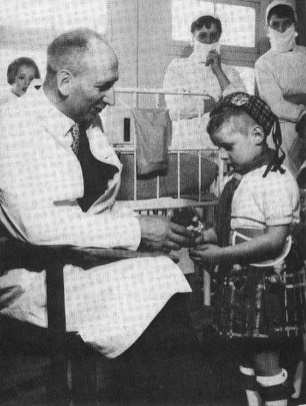
Despite the economic and political turmoil going on around him, Dutch pediatrician Willem Dicke is caring for his patients at Juliana’s Children’s Hospital in The Hague.
At this point in time, a variety of diets had been suggested for treatment of Gee-Herter disease including all fruit diet, the banana diet, puree of potatoes or tomatoes, beef steak, the milk diet. Doctors knew diet was important, but they just couldn’t find the “magic diet”…until Willem Dicke.
During a pediatric conference in 1932, Dicke was interested in a case report from fellow countryman Hendrik Albert Stheeman. Stheeman presented information about relapses of diarrhea after consuming bread and rusks (a dry, hard biscuit often used a baby teething food).
According to Dicke’s wife, her husband had begun experimenting with wheat-free diets between 1934 and 1936.
“It was a young mother’s statement of her coeliac child’s rash improving rapidly if she removed bread from the diet, that alerted his interest, when he was a pediatrician in the Hague in 1936”
Dicke published his first report in 1941 titled, “W K Dicke: A simple diet for Gee-Herter’s Syndrome”. In it he writes:
“In recent literature it is stated that the diet of Haas (Banana-diet) and Fanconi (fruit and vegetables) gives the best results in the treatment of patients suffering from coeliac disease. At present (World War II) these items are not available. Therefore, I give a simple diet, which is helping these children at this time of rationing. The diet should not contain any bread or rusks. A hot meal twice a day is also well tolerated. The third meal can be sweet or sour porridge (without any wheat flour).”
The German occupation of the Netherlands was taking its toll. The Dutch government called for a national railroad strike that crippled the German supply line. The “Hunger Winter” of 1944/1945 was the result of German retaliation for the Dutch railroad strike. In September 1944, the uninvited guests locked down all roads which meant nothing moved without German authorization. This action resulted in devastating food and fuel shortages throughout the country during one of the coldest winters.
Eventually, every day staples (like bread) dried up. This forced people to seek out other food sources like tulip bulbs and beet roots. First hand accounts report “…few things are of fouler taste than tulip bulbs.”
The devastating food shortages brought about some unintended discoveries. The ever-observant Dicke noticed the children under his care flourished during the “Winter of Starvation”. He also noticed the mortality rate dropped from 35%-40% (pre-war) to zero. That’s correct, roughly one third of the children with celiac disease did not live. The recent observations corroborated his findings almost decade earlier.
Mere days before the end of the war, starting on April 29th, 1945, Operations Manna and Chowhound airdropped almost 11,000 pound of food to the starving citizens of the Netherlands. Of course, bread and other gluten-filled foodstuffs were part of the food drop. Once these foods were regularly consumed, the children’s health started deteriorating.
At the 1946 International Congress of Pediatrics held in New York, Dicke reported his findings; he was not taken seriously.
In 1950, Dicke published a thesis. In it he describes the meticulous dietary studies that started in 1936 and transpired over several years at Juliana’s Children’s Hospital. One study centered around a single patient. While in the hospital the boy’s clinical symptoms, weight, growth showed favorable response to a strict wheat-free diet. However, each time the boy went home, the wheat-free diet could not be maintained, he suffered set backs in his growth curve. During each of the four longterm admissions to the hospital, his growth trends would work their way towards normal.
By tracking growth curves of multiple children treated with wheat-free diet and comparing them to age matched [healthy] controls Dicke concludes:
“- if certain types of meal, such as wheat, and rye are replaced in the daily diet, the patient improves; - acute attacks of diarrhoea, do not occur, provided these types of meal are not given; - after a latent period which can vary in length, deterioration and acute attacks of diarrhea re-occur, if the objectionable type of meal are added to the diet too soon…”
Working with other experts, Dicke also included in his thesis the results of their dietary fat absorption experiments. They were able to accurately measure fecal fat content, total fecal output, fat absorption. The conclusion of his thesis was that wheat flour and rye flour - not well purified wheat starch (amylum) triggered the anorexia, the increased fecal output, and the increased fecal fat. The creation of the gluten-free diet was based upon these findings. A few years later [in 1953], he published a series papers further documenting the role that gluten from wheat & rye plays in celiac disease.
Even though Dicke’s findings were quickly confirmed by other researchers from Britain, Scandinavia, and Germany, some skepticism remained about the efficacy of the gluten-free diet - particularly from American publications.Additional information
Willem-Karel Dicke: Pioneer in Gluten-Free Diet in the Treatment of Celiac Disease by Jefferson Adams bit.ly/1LjWNzG Willem-Karel Dicke: 40 years of Gluten-Free Diet edited by M.L Mearin, Chr.J Mulde goo.gl/fHmrBf Willem-Karel Dicke: Over 50 years of Gluten-Free Diet by G P van Berge-Henegouwen and C J Mulder bit.ly/1KFlL2d 
”As World War II drew to a close, Nazi-occupied Holland starved. To avert a humanitarian disaster, Allied aircraft dropped food, not bombs, onto the Netherlands in an operation fraught with enormous risks, not the least of which was trusting the Nazis.”
History.com Operation Chowhound ”How Famine Under the Nazis Revealed the Cause of Celiac Disease”
A food shortage helped one doctor prove his theory.
BY ANNE EWBANK MARCH 29, 2018
”Months into the Nazi occupation, he presented a speech to the Dutch Society of Pediatrics. In it, he observed that the banana diet popularized by Haas did ward off celiac. But there was one problem: The wartime Netherlands had no bananas, and the whole country was under strict rationing. He proposed the following alternative: absolutely no bread, the occasional biscuit, and “sweet or sour porridge” that had no wheat flour.”
A most facinating account of Dr. Dicke’s work. One of the most detailed I’ve seen.
Atlas Obscura http://bit.ly/2IktdjP Even 40 years later, after Dicke overwhelmingly demonstrated that wheat protein [not starch/carbohydrate] that was the root of the problem; Haas still insisted that "all patients are cured by the Specific Carbohydrate Diet, a cure which is permanent without relapse”.

An estimated 20,000 people lost their lives due to the widespread starvation. One of the children living a blockaded area was fifteen year old Audrey Hepburn.
Surviving conditions like jaundice, anemia and respiratory problems, she went on to become the Hollywood star we have come to know and love.
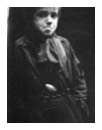
Dutch boy waiting at a restaurant during the Hunger Winter. Beyond DNA: Epigenetics An interesting article about the long term health affects of the Hunger Winter.
The experiences of our ancestors are leaving their marks on our DNA.
-
Charlotte Anderson (1915 – 2002)Coming soon…
-
John W. PaulleyComing soon…
-
Margot Shiner (1923 – 1998)Coming soon…
-
William H. Crosby Jr. (1914 – 2005)Coming soon…
03/31/18 - Added Atlas Obscura article to Willem Karel Dicke’s section.

